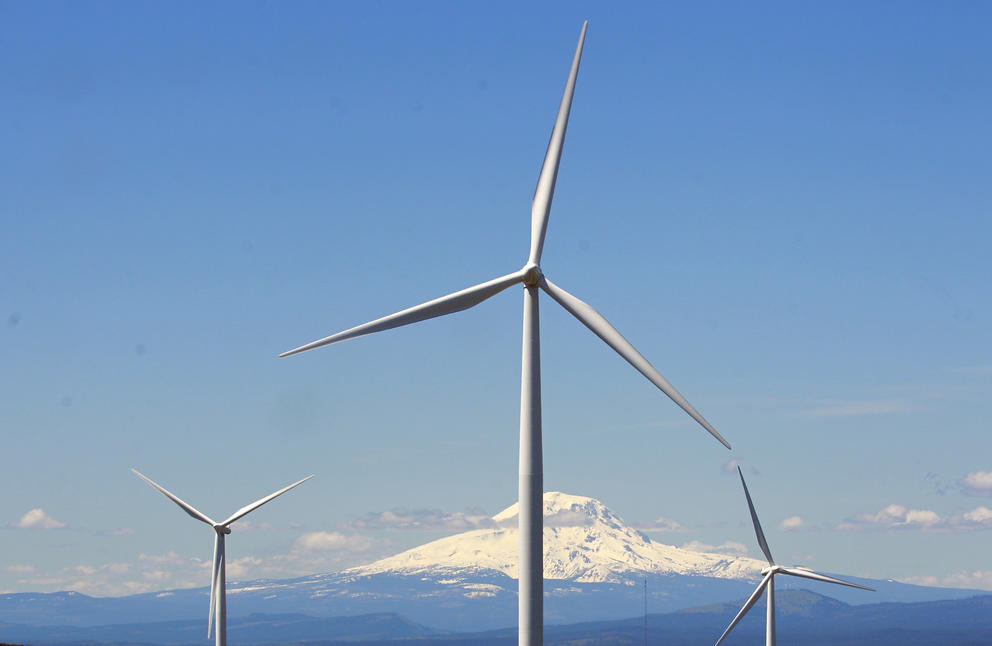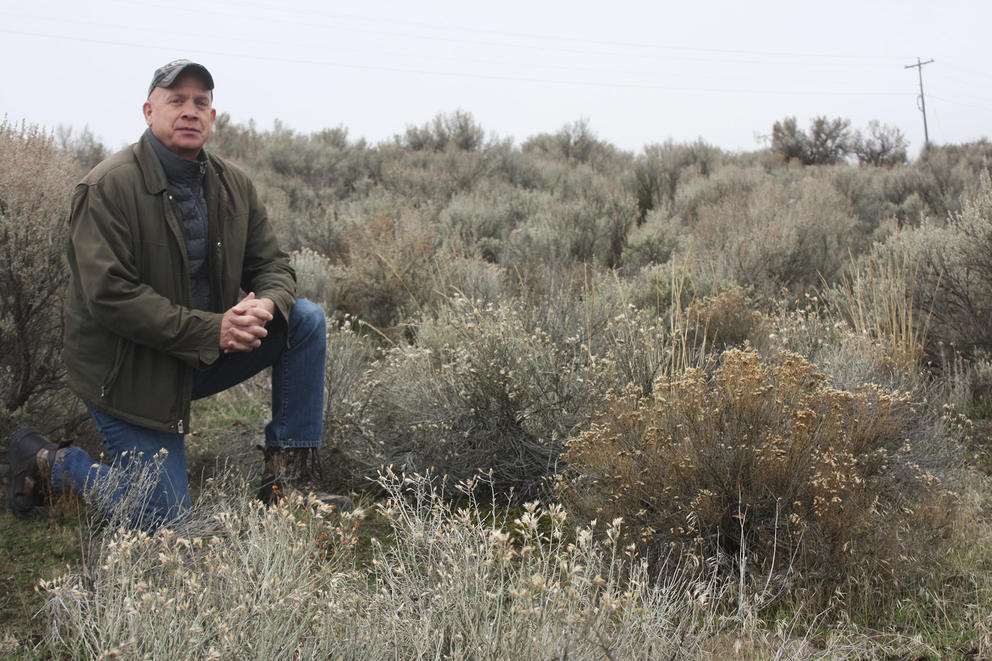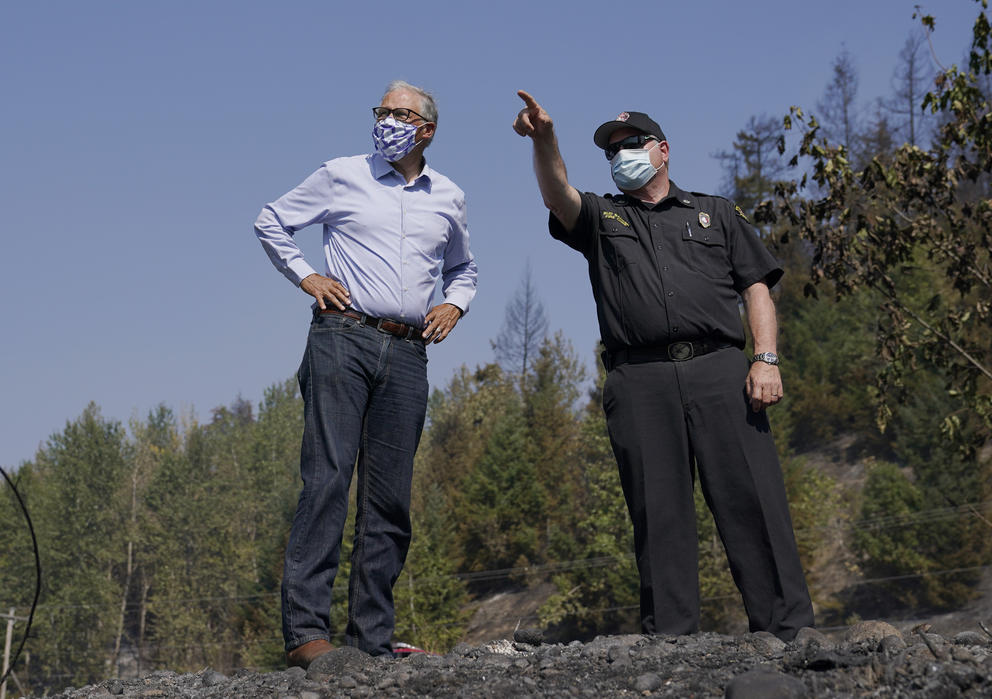Shrub-steppe still covers a good chunk of Eastern Washington, but much less than before. It has shrunk from an estimated 10.4 million acres filled with unique birds and critters in the 19th century to 40% of that now. Farms and towns have been gobbling up the habitat for more than a century.
Now, Washington’s shrub-steppe, with its critical wildlife habitat, faces potential encroachment by wind turbines and solar panel farms. Lots of them. And these alternative energy development are setting up a surprising environmental conflict between cleaner energy and preserving the land as wildlife habitat, sometimes pitting environmentalists against other environmentalists.
Renewable energy resources — wind and solar — are significant planks in Gov. Jay Inslee’s fight against global warming, which creates wildfires, acid rain and heat waves that harm wildlife, the economy and people’s health in Washington.
“We shouldn’t be put in the position of having to defend against green energy with our conservation needs. .... It’s a no-win situation,” said Barbara Baker, a member of the Washington Fish and Wildlife Commission, when a commission committee was briefed on this issue last September,
“There is no black and white answer,” Inslee said. “When we do make siting decisions, we have to take that into consideration”
How big is this new industry?
One of Washington’s proposed wind turbine projects is in the Horse Heaven Hills. Many Tri-Citians complain the project will ruin their views of the ridges, while threatening the ferruginous hawks that fly overhead. Several months ago, the state government listed ferruginous hawks as endangered.
No official clearinghouse lists the state’s solar panel and wind turbine farms. That’s because renewable energy developers have the choice of seeking their permits from either the state or host county governments. If a developer chooses the state option, the Energy Facilities Site Evaluation Council reviews the application and makes recommendations to the governor for a final decision. An Inslee spokesman said the governor does not comment on any project before making a decision.
As a state biologist, Ritter focuses on the effects turbines and solar farms have on birds and animals. Through legwork and phone calls confirming grapevine rumors, he keeps an unofficial tally on these projects. Washington has 24 operational wind turbine farms, plus 12 in the construction, permitting or brainstorming stages. Meanwhile, there are two functioning solar panel farms in the state, plus at least 38 in construction, permitting or proposal stages.
Construction unions have spoken up in favor of Inslee’s plans to generate more renewable energy in Washington state, which the governor touts as job creators. But, mostly, Inslee is continuing his crusade against global warming.
In 2016, the state Department of Ecology set up regulations calling for the state’s electricity to be 100% carbon-free by 2045. A major part of achieving that goal is solar and wind power. In 2019, the state Legislature passed a law nailing down the same goal.
This target of a carbon-free power grid has sparked a surge of solar panel farm proposals in Washington, really taking off in the past four years, Ritter said.
“It’s kind of a gold rush right now on solar sitings,” said Molly Linville, a member of the Washington Fish and Wildlife Commission, in an interview.
Linville is also a Douglas County rancher and farmer, whose land has been in her family for at least 100 years. Letters routinely arrive in the mail with offers for some of her family’s land to be used for solar farms. Also routine are phone calls from those same developers. So far, the Linville family has not been interested.
Meanwhile, Connecticut-based Avangrid Renewables — with at least 48 wind turbine farms and 14 solar panel farms nationwide — is pursuing a solar farm near the Linvilles’ farm in Douglas County on the plateau-like Badger Mountain, 3.5 miles east of East Wenatchee. The farm is seeking a state permit. Avangrid did not respond to several emails and voicemails from Crosscut seeking an interview.
Linville said the state government doesn’t currently have enough staff members to study individual wind and solar projects’ impact on habitat birds and wildlife. “The cabinet agencies weren’t ready. We’re trying to play catch up,” Linville said.
Discussion in Olympia
Inslee’s budget proposal for the 2022 legislative session includes some money for more staff at the Department of Fish and Wildlife to help with mitigation for solar farm proposals — an attempt to do a better job of balancing clean energy generation with preserving critical habitat.
The proposed budget would also give money to the Department of Ecology to hire staff to improve the siting of renewable resources and to help with permitting. It also calls for the state Department of Commerce to study what happens when solar farms and agriculture occupy the same fields.
Meanwhile, two conflicting bills collided recently in the state Legislature's House Environment and Energy Committee.
State Rep. Mark Klicker, R-Walla Walla, introduced one bill to stop the site evaluation council from reviewing solar and wind projects until late 2023 after a task force studies the topic. Klicker represents much of Benton County, where heavy opposition has surfaced to the Horse Heaven Hills wind turbine proposal — mostly because many Tri-Citians don’t want to see windmills on their southern horizon.
A hearing before the House Energy and Environment Committee stressed Eastern Washington residents believe wind and solar farms are chipping away at their tax bases, and that Eastern Washington is being unfairly targeted to provide most of the state’s alternative energy. Opponents argued the site evaluation council is not receptive to local concerns. Habitat concerns did not pop up in this hearing.
“You guys are in too big of a hurry to meet climate change goals,” said Klickitat County Commissioner Dan Christopher. Josh Weiss, a lobbyist for the Benton County government, said county planning commissions are capable of dealing with these projects.
However, Kathleen Drew, chairwoman of the site evaluation council, said the council has approved only three wind and solar projects so far, with only a handful still under review. “The vast majority of wind and solar have gone before the county governments. I believe [the council’s] siting process is the most thorough environmental review,” she added.
At the same hearing, the House committee heard testimony that mostly supported a bill by Rep. Joe Fitzgibbon, D-West Seattle, that would bolster the authority of the site evaluation council, while also boosting tribal participation when needed. The Tulalip, Yakama and Puyallup nations warned against streamlining the review process too much. The Department of Fish and Wildlife supported the bill, testifying about guarding habitat from solar and wind farms. On Feb. 3, the committee passed Fitzgibbon’s bill and sent it forward toward a full House vote. Since Democrat Fitzgibbon is the committee’s chairman, Klicker’s bill appears likely to die in committee.
In this April 20, 2013, file photo, male greater sage grouse perform mating rituals for a female grouse, not pictured, on a lake outside Walden, Colorado. The Biden administration is considering new measures to protect the ground-dwelling bird, once found across much of the U.S. West. It has lost vast areas of habitat in recent decades because of oil and gas drilling, grazing, wildfires and other pressures. (David Zalubowski/AP)
Why shrub-steppe is critical habitat
Found in Eastern Washington and other Western states, shrub-steppe consists of arid rolling grassy plains filled with sagebrush and other woody shrubs on a thin crust made up of mosses, lichens, algae and bacteria. As one of Washington’s most diverse ecosystems, shrub-steppe provides habitat for species found nowhere else in the state, such as the greater sage grouse, listed as endangered by the state; sagebrush sparrows, which are candidates for a state listing for protection; and burrowing owls; also candidates to be listed for state protection.
Ritter, the state biologist, has consulted on many wind and solar projects, with the developers sometimes following his recommendations and others following little of his advice. Some sites are filled with shrub-steppe, and some have little of that critical habitat.
Linville and Ritter voiced concern about some developers locking themselves into specific sites before consulting with state wildlife experts. However, Ritter added many developers do their habitat research in a timely manner.
At a state Fish and Wildlife Commission briefing on this issue, Linville said: “There is a big public sense that these companies … will get a bit of a free pass [in getting their projects approved].”
At the same briefing, Ritter said: “They ask me how to mitigate for the sage grouse. There is no mitigation. You don’t build there. … It’s like they think when they get into the permitting process, it’s going to happen. We may tweak it a little bit, but it’s going to get in. That’s too late. I wish the companies would reach out to us first.”
Segue to Douglas County, which is the shrub-steppe home to most of Washington’s 700 sage grouse.
Sage grouse habitat once covered most of Central Washington. Now only 8% of that habitat remains in three scattered segments, of which an area east of East Wenatchee in Douglas County is by far the biggest. A Fish and Wildlife Department letter said recent wildfires have cut into that remaining 8%. ”Douglas County is pretty unique in its habitat for sage grouse,” said Mike Livingstone, a member of the site evaluation council.
Sage grouse need large areas of undisturbed shrub-steppe to survive. They rely on the sagebrush for cover and a year-round food source, and they are sensitive to human disturbance, especially during the breeding season. “They couldn’t exist anywhere else if shrub-steppe no longer exists,” Linville said.
Avangrid’s proposed Badger Mountain site — almost 7 square miles designed to hold slightly more than 2 square miles of solar panels generating 200 megawatts — is in the permit applicant stage with the site evaluation council. Less than 3% of the site contains shrub-steppe. “We’re trying to stay out of shrub-steppe habitat,” said Avangrid project manager Scott Kingren at a public hearing on the project.
However, the issue is more complicated. The site is adjacent to shrub-steppe being nibbled away by forest wildfires to the west. “You get a big fire every three years, every five years, and it can’t recover,” Ritter said.
Environmentalists recognize the dichotomy in this debate.
“The Sierra Club has a long history of supporting renewable energy in Washington state, but clean energy must be developed so it does not destroy the habitat of our endangered species,” Margie Van Cleve of the Washington Sierra Club said during a council hearing on the Douglas County project. “There’s a chance that this project alone can remove this species from the state of Washington,” said Keith Watson of Conservation Northwest at the same hearing.
On Dec. 10, the Fish and Wildlife Department sent a letter to the siting council that was critical of the Badger Mountain project’s impact on sage grouse, golden eagles and ferruginous hawks. Golden eagles are not on any official state or federal lists for protection, but the state Fish and Wildlife Department has voiced concerns about keeping this species viable in Washington.
While most of the Badger Mountain project is on existing wheat land, the Dec. 10 letter said the mosaic of shrub-steppe and agricultural land is vital to sage grouse for rearing, foraging, migration and movement.
"Siting the [Avangrid projects] in such proximity to the largest traditional display ground in the state and proposing to construct within and over critical sage-grouse habitat and movement corridors at this location will negatively impact sage-grouse use on the Badger Mountain Plateau. Loss and fragmentation of sage-grouse habitat is not consistent with sage-grouse population stabilization and population recovery,” the letter said..
Meanwhile, Scout Clean Energy of Boulder, Coloraado, has proposed building up to 224 wind turbines — about 50 feet tall — on 112 square miles of mostly private land in the Horse Heaven Hills. About 294 acres of that land would also hold solar panels. The wind turbines and solar panels are projected to produce 1,150 megawattts. That’s roughly the same output as the Columbia Generating Station, a commercial nuclear reactor just north of the Tri-Cities. Scout Energy did not respond to several email and voicemail requests for an interview.
If built, that wind project would be the second in Benton County. Richland-based Energy Northwest, which owns and operates the Columbia Generating Station, built and operates 63 wind turbines several miles southeast of the northern face of the Horse Heaven Hills. Completed in 2007, that site covers about 8 square miles and produces almost 96 megawatts.
Energy Northwest’s turbines have not been controversial, but they cannot be seen from the Tri-Cities. Scout’s turbines would be visible, a major factor in Benton County residents’ opposition to the project.
Benton County’s government received about 400 phone calls and emails about the project, with about 90% opposing it, Benton County Commissioner Will McKay said in a March hearing. Scout commissioned its own poll of 500 people in December 2020. It showed 34% opposed it.
"Scout recognizes this is the first step in a very long process," said project manager Dave Kobus at the March hearing.
Scout sees a predicted power shortage of 8,000 megawatts in Washington, Oregon, Idaho and Montana by 2030, with its project contributing to fix that shortfall. The company has five wind and solar sites in Texas, Oklahoma, Indiana and California.
A hawk problem
At the March hearing, local resident John Christian said the turbine threatened the area’s ferruginous hawks. "You cannot construct a kill zone of wind turbines in this area," he said.
In August, the Fish and Wildlife Commission changed the status of ferruginous hawks from threatened to endangered. Climate change and wind turbines were two of several factors contributing to that decision.
While the federal government does not list the ferruginous hawks as a threatened or endangered species, they are listed for protection by the state of Washington. The species has struggled here because of a shrinking prey population, habitat encroachment by expanding agriculture, deaths from wind turbine strikes and wildfire destruction of nesting areas. The ferruginous hawks spend five months a year in the state, when they nest from April through the summer; they migrate elsewhere in the Western U.S. for the other seven months.
The birds are among the nation’s largest hawks, with average wingspans of 56 inches. They live in grasslands and shrub-steppes. The Department of Fish and Wildlife tallied 55 nesting pairs of hawks in 1995 and 32 pairs in 2016, according to an August 2021 department report to the commission. About 60% of the nesting pairs are found in Benton and Franklin counties. The August report pointed to climate change as one reason to downgrade the hawk population to endangered.
Ferruginous hawks tend to focus on a few specific species as prey, such as ground squirrels. They are reluctant to expand their diets, said James Watson, a state researcher, and one of the August report’s authors, in a September interview. Watson said eight ferruginous hawks have been killed by Washington wind turbines since 2001.
However, Ritter said Scout has done a good job of picking locations for individual turbines to avoid ferruginous hawk nesting areas and flight paths. “They know what they need to do,” Ritter said.






